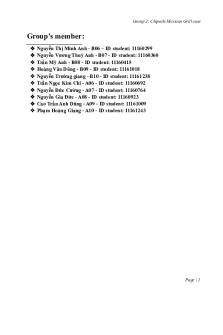MGT555 Individual Assignment 1 PDF

| Title | MGT555 Individual Assignment 1 |
|---|---|
| Course | Business Analytic |
| Institution | Universiti Teknologi MARA |
| Pages | 13 |
| File Size | 866.5 KB |
| File Type | |
| Total Downloads | 430 |
| Total Views | 531 |
Summary
FACULTY OF BUSINESS AND MANAGEMENTBACHELOR OF BUSINESS ADMINISTRATION (HONS.) INMARKETING (BA240)BUSINESS ANALYTICS (MGT555)INDIVIDUAL ASSIGNMENT 1PREPARED BY :NORSHAHALIZA BINTI TANGKAPAN AZMI2020994945BA2403APREPARED FOR :MDM NURUL HIDAYAH MAT NORSUBMISSION DATE :26 NOVEMBER 2020DEVELPOMENT OF BUS...
Description
FACULTY OF BUSINESS AND MANAGEMENT BACHELOR OF BUSINESS ADMINISTRATION (HONS.) IN MARKETING (BA240)
BUSINESS ANALYTICS (MGT555) INDIVIDUAL ASSIGNMENT 1
PREPARED BY : NORSHAHALIZA BINTI TANGKAPAN AZMI 2020994945 BA2403A2
PREPARED FOR : MDM NURUL HIDAYAH MAT NOR
SUBMISSION DATE : 26 NOVEMBER 2020
DEVELPOMENT OF BUSINESS ANALYTICS STAGES
Pre Industrial Era
Pre Industrial Era refers to the era when the production work is done manually without the uses of any technology. During this era, machines were not exist yet to be formerly introduced hence scale of production was given less importance because it need high level of efforts to do things manually. Even though data were recorded using manual basis either in books or ledgers, it was not thoroughly engaged in business decision making. Even so, the elements of business analytics was existed way back then when business engaged with the uses of data.
Industrial Era
After pre industrial era, the industry developed to industrial era where machines and scale of production revolutionizing the manufacturing industry. In this era, the production were given greater attention unlike during pre industrial era. Data was formally recorded in ledgers but the usage of data was still limited since there are no technology that able to share data. Therefore, even with the existences of machines, data were still collected manually. Despite the challenges, analysts still need to collect data to secure competitive advantage of their business.
Digital Era
After the end of industrial era, the industry is developing into digital era where computers were widely used in large organizations. The era has become more developed than ever where computers are used to store and record data as well as to perform simple analysis. Starting from late 1980s, computers were extremely used and is famously known as the information age where people are able to perform basically anything with the uses of technology. The introduction of Microsoft Excel in this era completely changed the way data was recorded. Ever since, business analytics has become an industry on its own today.
PIVOT TABLE, PIVOT CHART AND BASIC EXCEL FUNCTION
a.
Number/ percentage of loans by different purpose.
Row Labels Business Education Furniture Large Appliance New Car Other Repairs Retraining Small Appliance Used Car Grand Total
Count of Loan Purpose 10.35% 5.41% 20.00% 0.94% 24.47% 1.41% 2.82% 0.47% 24.71% 9.41% 100.00%
The Pivot Table and Pivot chart above shows the percentage of loans by different purposes. The percentage is based on several purposes which is including business, education, furniture, large appliance, new car, repairs, retraining, small appliance, used car as well as other purpose. From the bar chart above, it can be concluded that majority of people make loans with the purpose of getting new car and also small appliance with percentage of 24.47% and 24.71% respectively. While 20% of the people make loans to spent on furniture, 10.35% used loans for their business purpose. Used car comes next with total of 9.41% of the people and education purpose with 5.41%. There is only small number of people that used loans in purpose of large appliance, repairs, retraining and other.
b.
Martial Status and Housing Type
Count of Housing Row Labels Divorced Married Single Grand Total
Column Labels Other
11
Own Rent 98 30 41 164
47 6 28
Grand Total 156 36 233
52 292
81
425
The Pivot Chart and Pivot table above indicates the martial status of the loan makers and their housing type. From the bar chat above, it can be shown that majority of the divorced loaners owns house with total of 98 people while 47 of them renting house. On the other hand, most of the married loaner owned houses while the remaining 6 person did not. As for the single loaners, majority of them where 164 person have their own house and only 28 of them rent houses while the remaining 41 of them are neither own or rent house. In summary, majority of the loaners are from the single loaners and most of them owning houses compared to divorced and married loaners.
c.
The number of loans by different purposes, marital status and credit risk.
Count of Loan Column Purpose Labels Divorced Married Single Grand Divorced Married Single Total Total Total Total Row Labels High Low High Low High Low Business 12 2 14 1 3 4 10 16 26 44 Education 8 5 13 1 1 6 3 9 23 Furniture 24 20 44 2 3 5 17 19 36 85 Large Appliance 1 1 1 1 1 1 2 4 New Car 25 12 37 4 4 8 36 23 59 104 Other 1 1 2 3 1 4 6 Repairs 3 3 6 1 1 1 4 5 12 Retraining 1 1 1 1 2 Small Appliance 14 18 32 7 6 13 21 39 60 105 Used Car 3 4 7 1 1 2 8 23 31 40 Grand Total 91 65 156 17 19 36 103 130 233 425
The Pivot table and Pivot chart illustrates the number of loans by different purposes, marital status and credit risk. It can be seen from the chart that divorced loaners has the higher risk of credit with the purpose of new car, small appliances, and furniture meanwhile their top three of purpose loans that has lower credit risks are including furniture, small appliances and also new car. On the other hand, the purpose of loan by the married loaners that has higher credit risk are consist of small appliances, new car and used car as well. In contrast, married loaners that has lower credit risk make loans mainly for small appliances purpose. As for the single loaners that has high credit risk, the purpose of them making loans is for getting new car meanwhile single loaners that has lower credit risk use their loans for the purpose of small appliances. Most of the loaners that has lower credit risk are from single loaners.
d.
Gender and credit risk.
Count of Credit Risk Row Labels F M Grand Total
Column Labels High 78 133 211
Low Grand Total 57 157 214
135 290 425
The Pivot chart and Pivot table illustrate number of credit risk based on gender of the loaners. For the female loaner, the number of them that has high credit risk is more high compared to the low credit risk. Male loaners on the other hand consist of higher loaner with lower credit risk rather than loaners that has higher credit risk. It can be concluded that there is large number of male loaners than the female loaners.
e.
The number of loans by different purposes, Job and credit risk.
Count of Loan Column Purpose Labels
Row Labels Business Education Furniture Large Appliance New Car Other Repairs Retraining Small Appliance Used Car Grand Total
Unem Unskill ploye Uns kille ed Managem Managem Skille Skilled Unempl Grand d Total Total ent ent Total d Total oyed Total d High Low High Low High Low High Low 5 1 6 13 13 26 1 1 4 7 11 44 3 3 9 5 14 2 4 6 23 3 2 5 31 31 62 1 1 8 9 17 85
8 4
3 2 28
5 1
4 13 26
13 5
7 15 54
2 40
1 21
3 61
1 1
6 1
7 2
29 45 9 13 135 136
74 22 271
2 1
5
3 1 1
1 6
5 1 2
1 11
1 15
10
1 25
2
1
3
10 1 43
14 1 46
24 2 89
By referring to both table and Pivot Chart above, it can be seen that there the loaners are consist of different type of job whether management, skilled, unskilled or even unemployed. For management job, the highest number of credit risks loaners are the loaners that use loans to get new cars meanwhile for the lower credit risk, the highest number are from the loaners that use their loans for used cars. Majority of the skilled loaners has lower credit risk make loans with the purpose of getting new cars while majority of unemployed loaners has higher credit risk and used loan for the purpose of small appliances. Lastly for the unskilled loaners, majority of them has higher credit risk and using loan in purpose of getting used cars.
4 104 6 12 2 105 40 425
DECRIPTIVE STATISTIC TOOLS
The are several elements in the measure of central tendencies which is firstly mean. Mean can defined as the average number in a data set. Mean can be calculated by dividing the total or sum of all the observations by the number in the data values. The formula for mean is =AVERAGE(data range). Based on the Coffee Share data on Excel, the mean for the prices of share is 140.75.
Other than that, variance. Using basic excel function, variance can be calculated using the formula =VAR.S(data range). Variance is used to measures how far each number in the set is from the mean. By using the descriptive statistic tools in the Coffee Share data, the variance for the prices of share is 1336.56818.
On the other hand, standard deviation is used in measuring the amount of variation or dispersion of a set of values. In short, standard deviation basically tells us how far the numbers are from the mean. Standard deviation can be calculated by entering the formula =STDEV.S(data range). In the Coffee share data, the standard deviation of the price of share is 36.55910532.
LA Mean Standard Error Median Mode Standard Deviation Sample Variance Kurtosis Skewness Range Minimum Maximum Sum Count
140.75 10.55370465 128.5 123 36.55910532 1336.568182 -0.482211335 0.877705822 109 104 213 1689 12
TABLEAU i.
Shipping Cost by Country
ii.
Shipping by Regions
1651 Words...
Similar Free PDFs

MGT555 Individual Assignment 1
- 13 Pages

Assignment Individual 1 MGT555
- 13 Pages

Individual Assignment 1 (1)
- 8 Pages

Individual Assignment 1
- 1 Pages

Individual Assignment 1
- 6 Pages

MKT540 INDIVIDUAL ASSIGNMENT 1
- 6 Pages

IMD122 Individual Assignment 1
- 15 Pages

Assignment 1 - individual
- 7 Pages

Individual Assignment 1
- 1 Pages

Individual Assignment
- 26 Pages

Individual Assignment
- 20 Pages

Individual assignment
- 5 Pages
Popular Institutions
- Tinajero National High School - Annex
- Politeknik Caltex Riau
- Yokohama City University
- SGT University
- University of Al-Qadisiyah
- Divine Word College of Vigan
- Techniek College Rotterdam
- Universidade de Santiago
- Universiti Teknologi MARA Cawangan Johor Kampus Pasir Gudang
- Poltekkes Kemenkes Yogyakarta
- Baguio City National High School
- Colegio san marcos
- preparatoria uno
- Centro de Bachillerato Tecnológico Industrial y de Servicios No. 107
- Dalian Maritime University
- Quang Trung Secondary School
- Colegio Tecnológico en Informática
- Corporación Regional de Educación Superior
- Grupo CEDVA
- Dar Al Uloom University
- Centro de Estudios Preuniversitarios de la Universidad Nacional de Ingeniería
- 上智大学
- Aakash International School, Nuna Majara
- San Felipe Neri Catholic School
- Kang Chiao International School - New Taipei City
- Misamis Occidental National High School
- Institución Educativa Escuela Normal Juan Ladrilleros
- Kolehiyo ng Pantukan
- Batanes State College
- Instituto Continental
- Sekolah Menengah Kejuruan Kesehatan Kaltara (Tarakan)
- Colegio de La Inmaculada Concepcion - Cebu



